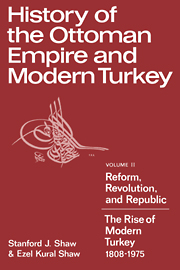Book contents
- Frontmatter
- Contents
- List of Tables
- Preface
- Preface to the second printing
- List of Abbreviations
- Note on Pronunciation
- Map of the Growth of the Ottoman Empire, 1280–1683
- Map of the Decline of the Ottoman Empire, 1683–1975
- 1 The Beginnings of Modern Ottoman Reform: The Era of Mahmut II, 1808–1839
- 2 The Era of Modern Reform: The Tanzimat, 1839–1876
- 3 Culmination of the Tanzimat: The Reign of Abdulhamit II, 1876–1909
- 4 The Young Turk Period, 1908–1918
- 5 The Turkish War for Independence, 1918–1923
- 6 The Turkish Republic, 1923–1975
- Appendix
- Bibliography: History of the Ottoman Empire and Modern Turkey, 1808–1975
- Index
2 - The Era of Modern Reform: The Tanzimat, 1839–1876
Published online by Cambridge University Press: 20 May 2010
- Frontmatter
- Contents
- List of Tables
- Preface
- Preface to the second printing
- List of Abbreviations
- Note on Pronunciation
- Map of the Growth of the Ottoman Empire, 1280–1683
- Map of the Decline of the Ottoman Empire, 1683–1975
- 1 The Beginnings of Modern Ottoman Reform: The Era of Mahmut II, 1808–1839
- 2 The Era of Modern Reform: The Tanzimat, 1839–1876
- 3 Culmination of the Tanzimat: The Reign of Abdulhamit II, 1876–1909
- 4 The Young Turk Period, 1908–1918
- 5 The Turkish War for Independence, 1918–1923
- 6 The Turkish Republic, 1923–1975
- Appendix
- Bibliography: History of the Ottoman Empire and Modern Turkey, 1808–1975
- Index
Summary
The Tanzimat-i Hayriye, or “Auspicious Reorderings,” was a period of sustained legislation and reform that modernized Ottoman state and society, contributed to the further centralization of administration, and brought increased state participation in Ottoman society between 1839 and 1876. Its antecedents lay in the passion for “ordering” (nizam) that had guided the efforts of Gazi Hasan Paşa and Halil Hamit Paşa during the reign of Abdulhamit I (1774–1789) as well as those of Selim III and Mahmut II. It was the latter who made the Tanzimat possible by extending the scope of Ottoman government far beyond its traditional bounds to include the right and even the duty to regulate all aspects of life and changing the concept of Ottoman reform from the traditional one of attempting to preserve and restore the old institutions to a modern one of replacing them with new ones, some imported from the West. The successes as well as the failures of the Tanzimat movement in many ways directly determined the course reform was to take subsequently in the Turkish Republic to the present day. Leading the Tanzimat were Mahmut's sons, Abdulmecit I (1839–1861) and Abdulaziz (1861–1876), whose reigns encompassed the entire period and who provided the context in which the Tanzimat bureaucrats could and did proceed at their work.
The Accession of Abdulmecit I
The beginnings of the new reign were hardly auspicious. The old warrior Mehmet Husrev Paşa, who had fallen out of favor in Mahmut's later years, used his position as head of the Supreme Council (Meclis-i Vâlâ) to gain influence over his young and inexperienced heir-apparent, Abdulmecit, and planned to use the new regime to regain power.
- Type
- Chapter
- Information
- History of the Ottoman Empire and Modern Turkey , pp. 55 - 171Publisher: Cambridge University PressPrint publication year: 1977
- 1
- Cited by



